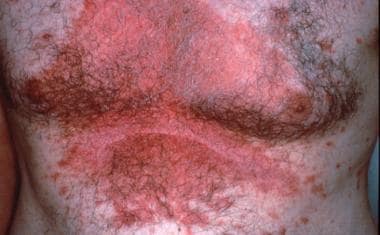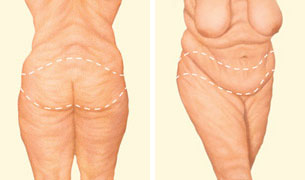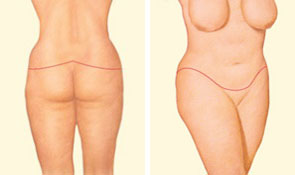If your wound is severe, you may have to undergo debriding, which is the removal of dead tissue, prior to reconstructive surgery.

Once that is done, there are several types of wound treatments your plastic surgeon may suggest:
- Skin grafts. This is often used for burn patients; skin is removed from one area of the body and transplanted to another. There are two types of skin graft: split-thickness grafts in which just a few layers of outer skinare transplanted and full-thickness grafts, which involve all of the dermis. There is usually permanent scarring that is noticeable.During a skin graft, a special skin-cutting instrument known as a dermatone removes the skin from an area (the donor site) usually hidden by clothing such as the buttocks or inner thigh. Once removed, the graft is placed on the area in need of covering and held in place by a dressing and a few stitches. The donor site is also covered with a dressing to prevent infection from occurring. Recovery time from a split-thickness skin graft is generally fairly rapid, often less than three weeks. For full-thickness skin graft patients the recovery time is a few weeks longer. Aside from burn patients, skin grafts can also be used during breast or nose reconstruction.

- Microsurgery. Have you lost a finger, toe, ear, or even a lip? Microsurgery may allow for those to be re-attached. Simply stated, it is a procedure in which the surgeon uses a microscope for surgical assistance in reconstructive procedures. By using a microscope, the surgeon can actually sew tiny blood vessels or nerves, allowing him or her to repair damaged nerves and arteries. This may also be a method to relieve facial paralysis or reconstruct breasts. Microsurgery is frequently used with other surgical procedures such as the free flap procedure.
- Free flap procedure. A free flap procedure is often performed during breast reconstruction or following surgery to remove head or neck cancer. During the procedure, muscle, skin, or bone is transferred along with the original blood supply from one area of the body (donor site) to the surgical site in order to reconstruct the area. The procedure often involves the use of microsurgery. Healing of the surgical site can be slow and require frequent wound care. Total recovery may take six to eight weeks or longer.
- Tissue expansion. Tissue expansion is a medical procedure that enables your body to “grow” extra skin for use in reconstructive procedures. This is accomplished by inserting an instrument known as a “balloon expander” under the skin near the area in need of repair. Over time, this balloon will be gradually filled with saline solution (salt water), slowly causing the skin to stretch and grow, much the same way a woman’s skin stretches during pregnancy.Once enough extra skin has been grown, it is then used to correct or reconstruct a damaged body part. This procedure is especially common for breast reconstruction.Tissue expansion has many advantages in that the skin color and texture are a near perfect match for the area in which it is needed and there is little scarring since there is no removal of skin from one area to another. The major drawback to tissue expansion is the length of the procedure, which can be as long as four months. During this period, as the balloon expander grows, the bulge under the skin grows with it. This bulge may be desirable for a breast reconstruction patient; however, for patients undergoing this procedure for scalp repair, the bulge may be uncomfortably noticeable.
What Happens After Surgery for Wound Treatment?
For any surgery involving the removal and transplantation of skin, it is extremely important that you follow the general instructions and guidelines for the care of your wound once you are sent home.
Daily Activity After Cosmetic Surgery
Easy does it! Remember, your energy level will decrease when you return home after cosmetic surgerycompared to when you were in the hospital. Patients often report being more tired and easily fatigued when at home than while they were in the hospital. You may find it helpful to set up a regular routine, but remember to pace yourself. If you are tired, take time to rest. Do not overdo it.
Skin Changes After Cosmetic Surgery
Be patient with your healing after cosmetic surgery to repair burns or wounds! As you continue to heal, you will notice changes in the color, appearance, and feeling of your skin at the surgical site. You also may notice numbness, a tingling sensation, or minimal feeling around your incisions. This is normal. These sensations will continue to improve over the next few months.
Perfusion and Circulation After Cosmetic Surgery
After your cosmetic surgery, it is important to monitor perfusion (passage of fluid) and circulation of the wound site. Avoid wearing clothing that constricts or applies pressure around your wound. Also, your doctor may give you a additional instructions to help with circulation to the wound.
The following are signs indicating that there may be an infection at the surgical site. Notify your doctor right away if you experience any of the following symptoms:
- White pimples or blisters around incision lines.
- An increase in redness, tenderness, or swelling of the surgical site.
- Drainage from the incision line. Occasionally, a small amount of bloody or clear yellow-tinged fluid may drain. Notify your doctor if it persists or if it changes in consistency.
- A marked or sudden increase in pain not relieved by the pain medication.
You may experience some other, more general signs of infection that will require medical treatment. If you notice any of the following symptoms of infection, it is important that you call your health care provider as soon as possible.
- A persistent elevation of body temperature greater than 100.5 degrees Fahrenheit (Take your temperature daily, at the same time each day
- Sweats or chills
- Skin rash
- Sore or scratchy throat or pain when swallowing
- Sinus drainage, nasal congestion, headaches, or tenderness along the upper cheekbones
- Persistent, dry or moist cough that lasts more than two days
- White patches in your mouth or on your tongue
- Nausea, vomiting, or diarrhea.
- Trouble urinating: pain or burning, constant urge or frequent urination
- Bloody, cloudy, or foul-smelling urine
























